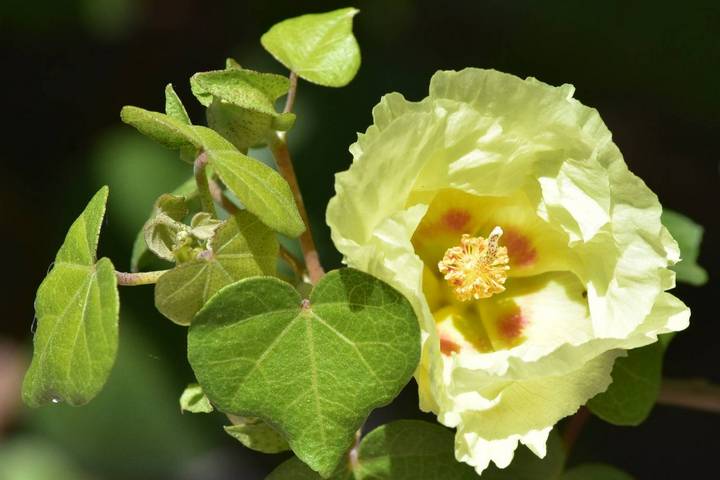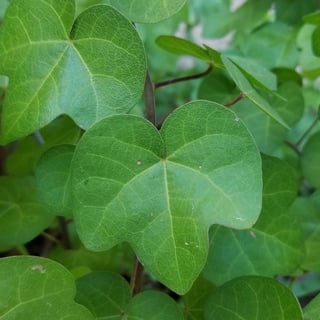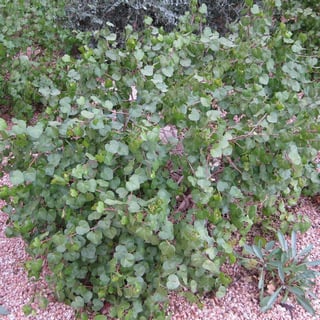San Marcos hibiscus is a Sonoran Desert native that makes a great alternative to tropical hibiscus species, which are notoriously challenging to grow in the desert. Here’s everything you need to know about planting and caring for this evergreen shrub.

San Marcos hibiscus (Gossypium harknessii) is a medium size shrub with thick heart-shaped leaves that resemble those of English ivy. Creamy yellow flowers with distinctive blushes of red bloom intermittently from spring through fall.
Growing tropical hibiscus can be challenging in the desert. They prefer high humidity, struggle with our intense sun, and are prone to iron chlorosis and numerous insect infestations including aphids, whiteflies, and mealy bugs.
Admittedly, San Marcos’s two inch flowers are not as showy, but this plant has many other attributes that make it a low-maintenance alternative worth considering.
Unlike “true” hibiscus, San Marcos thrives in poor soil, intense sun, and extreme heat. It needs minimal irrigation, never needs fertilizer, and has no insect pests.
If you’ve struggled to grow tropical hibiscus, you might want to give San Marcos hibiscus a try. In spite of its common name, it is not a true hibiscus. However, both tropical and San Marcos hibiscus belong to the same plant family (Malvaceae).
San Marcos hibiscus flowers attract bees and butterflies, and is a larval host for several species of moths and butterflies.
Why I Like This Plant
- Evergreen heart-shaped leaves
- Yellow flowers with long bloom period
- Sonoran Desert native
- Extremely low maintenance
- No thorns, non-toxic, low litter
- Supports butterflies, moths, bees

Things to Watch Out For
This is one desert plant that needs poor, rocky soil. Oddly, these plants often look worse for wear at nurseries, because they’re grown in soil too rich in organic matter.
Optimal Growing Conditions
If you’re thinking of adding a San Marcos hibiscus to your garden, you need to find a suitable place that will keep your plant healthy and looking good… while minimizing maintenance for you.
Here are the key factors to keep in mind.
Temperature
San Marcos hibiscus should be planted in USDA Hardiness Zones 9 – 11. It is extremely heat tolerant, up to 115℉. It is cold hardy down to 25℉ and may lose some leaves or die back in the twenties. It can survive down to 20℉.
Sun Exposure
San Marcos hibiscus grows best in full sun. It can tolerate some reflected heat, but its leaves may turn yellow when planted in the hottest spot in the garden — along a sunny, west-facing wall.
Size and Growth Rate
San Marcos hibiscus grows moderately fast. It typically reaches a size of 3 to 5 feet tall and 4 to 6 feet wide when mature. It grows faster and flowers more when given supplemental water.
This shrub flowers most prolifically in the spring and fall, but can bloom intermittently in the summer.

Soil
San Marcos hibiscus is particular about soil. In its native habitat, it grows in poor, well-draining, rocky soil, and that’s what it needs to thrive in gardens, too. If you plant it in fertile or amended soil, or cover it with organic mulch, it will not be happy.
San Marcos Hibiscus:
The Essentials
| Common Name | San Marcos hibiscus |
| Scientific Name | Gossypium harknessii |
| Origin | Mexico |
| Plant Type | Evergreen shrub |
| USDA Zones | Zones 9 – 11 |
| Cold Hardiness | To 25℉ |
| Flower Color | Pale yellow |
| Flower Season | Spring, summer, fall |
| Mature Size | 3-5′ tall x 4-6′ wide |
| Growth Rate | Moderate |
| Sun Tolerance | Full sun |
| Water Needs | Low |
| Garden Friendly | No thorns, non-toxic, low litter |
| Wildlife | Supports butterflies, bees, moths |
How to Plant
The rule of thumb when planting any shrub in the desert is to dig a hole three times as wide as the root ball but no deeper. Don’t be tempted to amend the soil or top with organic mulch. San Marcos hibiscus performs best in poor soil low in organic matter.
When to Plant San Marcos Hibiscus
The best time to plant San Marcos hibiscus is in the fall. This gives your shrub three seasons to grow roots and get established before the following summer.
The second best time is in spring, the earlier the better. This still gives your plant time to get established before the intense heat of June arrives.
How to Care for San Marcos Hibiscus
Whether you’ve recently planted a San Marcos hibiscus or have an existing plant in your yard, here’s how to take care of it to keep it healthy and looking its best.
How to Water New Plants
Once you’ve got your San Marcos hibiscus planted, watering is your most immediate concern. Here is the recommended watering schedule for new shrubs planted in the spring or fall.
| Weeks 1 & 2 | Every 3 – 4 days |
| Weeks 3 & 4 | Every 5 – 7 days |
| Weeks 5 & 6 | Every 7 – 10 days |
| Weeks 7 & 8 | Every 10 – 14 days |
After week 8, gradually extend the time between waterings.
How to Water Established Plants
Once your plant is established, water it every two to four weeks during the summer — no supplemental water is needed during the winter, provided you’ve had normal rainfall.
Don’t overwater this plant. Too much water and it gets rangy. However, too little water and its foliage gets sparse.
Should You Fertilize?
There’s no need to fertilize this plant. San Marcos hibiscus performs best when not fertilized.
How to Prune
San Marcos hibiscus naturally has an attractive rounded form and does not need regular pruning. You can lightly prune to shape or remove cold damage in early spring.
Plant Lover Facts
San Marcos hibiscus has a limited native range. It grows only in Baja California, Mexico, mostly near the sea, in washes, and on rocky slopes.
I could not find a definitive explanation for how this plant got its name. My best guess is that it’s named after the island of San Marcos in Baja California. I’ve seen its name attributed to San Marcos Growers, but that seems unlikely since this plant is not in their comprehensive database which includes thousands of plants.
San Marcos hibiscus (Gossypium harknessii) is closely related to Gossypium hirsutum, the cotton species responsible for 95% of world’s cotton production. G. hisutum is commonly called Mexican cotton or upland cotton. It’s native to Mexico, Central America, and northern South America.
Did you enjoy this article?
Sign up for our weekly newsletter
where you’ll find more great info on creating &
maintaining a beautiful, carefree desert landscape.
Author Bio
Deane Alban is the creator of Southwest Gardener. She is a science writer with a bachelor’s degree in botany from the University of South Florida. Gardening is her lifelong passion. She’s been gardening in Tucson for over 15 years.

